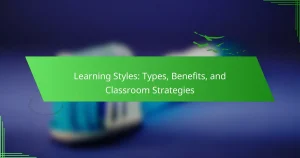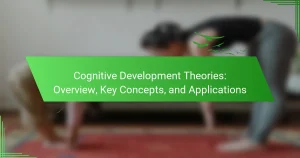Constructivist learning enhances critical thinking and problem-solving skills through active participation. Key principles include learner-centered approaches, social interaction, and the recognition of prior knowledge. This method fosters deeper understanding and retention of information. Real-world applications and authentic assessments further prepare learners for practical challenges.

What are the core principles of constructivist learning?
Constructivist learning is grounded in principles that emphasize active engagement and personal meaning-making. Key principles include learner-centered approaches, social interaction, and the importance of prior knowledge. These principles foster deeper understanding and retention of information.
Learner-centered approaches prioritize individual experiences, allowing students to construct knowledge through exploration. Social interaction encourages collaboration, enabling learners to share perspectives and challenge ideas. Recognizing prior knowledge helps connect new information to existing frameworks, enhancing comprehension and relevance.
Constructivist learning also values authentic assessment, where evaluation reflects real-world applications. This principle promotes critical thinking and problem-solving skills, preparing learners for practical challenges. Overall, these principles create a dynamic learning environment that supports personal growth and intellectual development.
How does active engagement enhance learning outcomes?
Active engagement significantly enhances learning outcomes by fostering deeper understanding and retention. It encourages students to take an active role in their education, promoting critical thinking and problem-solving skills. Research shows that learners who participate actively in discussions and hands-on activities retain information more effectively, leading to improved academic performance. Additionally, active engagement cultivates a sense of ownership and motivation, resulting in a more positive learning experience.
What role does social interaction play in constructivist learning?
Social interaction is crucial in constructivist learning as it enhances understanding through collaboration. Learners engage in dialogue, share perspectives, and co-create knowledge. This interaction fosters critical thinking and deeper comprehension, making learning more meaningful. Additionally, social interaction supports emotional development and motivation, which are essential for effective learning.
What are the stages of collaborative learning?
Collaborative learning typically involves four stages: forming, storming, norming, and performing. In the forming stage, group members establish relationships and set goals. The storming stage sees conflicts and differing opinions arise. During norming, the group develops cohesion and shared norms. Finally, in the performing stage, members work collaboratively towards common objectives, demonstrating the benefits of constructivist learning principles.
How can peer feedback improve understanding?
Peer feedback enhances understanding by promoting collaborative learning and critical thinking. It encourages students to articulate their thoughts, leading to deeper comprehension of concepts. Engaging with different perspectives fosters a more nuanced grasp of the material. Additionally, peer feedback helps identify gaps in knowledge, prompting further inquiry and exploration. This interactive process aligns with constructivist principles, emphasizing the importance of social interaction in learning.
Why is prior knowledge important in constructivist learning?
Prior knowledge is crucial in constructivist learning because it shapes how new information is interpreted and integrated. When learners connect new concepts to existing knowledge, they build deeper understanding and retention. This process enhances critical thinking and problem-solving skills. Research indicates that students who activate prior knowledge before learning new material perform better academically. Engaging with prior experiences also fosters motivation and relevance, making learning more meaningful.

What are the key benefits of constructivist learning?
Constructivist learning fosters critical thinking, collaboration, and deeper understanding. It encourages active participation, allowing learners to construct knowledge through experiences. This approach enhances retention and application of concepts. Additionally, it promotes adaptability and problem-solving skills, preparing students for real-world challenges.
How does constructivist learning promote critical thinking?
Constructivist learning promotes critical thinking by encouraging learners to actively engage with content and construct their understanding. This approach fosters inquiry, reflection, and collaborative problem-solving, essential for developing analytical skills.
Learners are motivated to question assumptions and explore diverse perspectives, enhancing their ability to evaluate information critically. Constructivist methods, such as project-based learning and discussions, create real-world contexts where learners apply critical thinking to solve complex problems.
Additionally, the emphasis on self-directed learning empowers individuals to take ownership of their educational journey, reinforcing their capacity for independent thought and decision-making. This autonomy in learning is a unique attribute of constructivist education, setting it apart from traditional methods.
What impact does constructivist learning have on student motivation?
Constructivist learning significantly enhances student motivation by promoting active engagement and personal relevance in learning experiences. This approach fosters autonomy, encouraging students to take ownership of their learning process. As a result, students often feel more invested in their education, leading to increased enthusiasm and persistence. Research indicates that when students are involved in constructing their knowledge, they are more likely to develop a deeper understanding and retain information longer.
How does it support diverse learning styles?
Constructivist learning supports diverse learning styles by encouraging active engagement and personal meaning-making. It accommodates visual, auditory, and kinesthetic learners through collaborative projects, discussions, and hands-on activities. This approach fosters critical thinking and adaptability, allowing learners to express their understanding in varied ways. As a result, it enhances retention and application of knowledge across different contexts.

What unique attributes define constructivist learning environments?
Constructivist learning environments are defined by attributes such as learner-centered approaches, collaborative activities, real-world relevance, and adaptability to individual needs. These unique attributes foster critical thinking and problem-solving skills, promoting deeper understanding through active participation.
How does flexibility in learning paths enhance student autonomy?
Flexibility in learning paths significantly enhances student autonomy by allowing learners to make choices that align with their interests and goals. This personalized approach fosters engagement and ownership of the learning process. Students can explore topics at their own pace, which promotes deeper understanding and retention of knowledge. Additionally, flexible pathways can accommodate diverse learning styles, making education more inclusive and effective. By enabling self-directed learning, students develop critical thinking and problem-solving skills essential for their future endeavors.
What innovative assessment methods are used in constructivist learning?
Innovative assessment methods in constructivist learning include project-based assessments, peer evaluations, self-assessments, and digital portfolios. These approaches encourage active engagement and reflection. Project-based assessments allow learners to apply knowledge in real-world contexts, enhancing critical thinking. Peer evaluations foster collaboration and communication skills. Self-assessments promote metacognition, enabling students to understand their learning processes. Digital portfolios showcase individual progress and creativity, offering a comprehensive view of learning outcomes.
How does the integration of technology shape constructivist learning?
The integration of technology enhances constructivist learning by facilitating active engagement and collaboration. Technology provides tools for interactive simulations, virtual environments, and collaborative platforms that support personalized learning experiences. These resources enable learners to explore concepts more deeply, experiment, and reflect on their understanding, aligning with the principles of constructivism. For instance, online forums allow students to discuss ideas, while educational software can adapt to individual learning paces. Overall, technology empowers learners to construct knowledge through meaningful interactions and experiences.

What are some rare attributes of successful constructivist learning implementations?
Successful constructivist learning implementations often exhibit rare attributes such as adaptability to diverse learning styles, integration of real-world problem-solving, and fostering a strong sense of community among learners. These elements enhance engagement and promote deeper understanding. Additionally, effective use of technology to facilitate collaboration and personalized learning experiences is a unique trait observed in exemplary cases.
What uncommon challenges do educators face in constructivist settings?
Educators in constructivist settings face several uncommon challenges, including managing diverse learning paces, facilitating collaborative learning, and assessing student understanding effectively. These challenges arise from the emphasis on individualized learning experiences and the need for active student engagement.
One challenge is the difficulty in balancing guidance and autonomy. Educators must provide support while encouraging students to take ownership of their learning. Additionally, fostering a collaborative environment can lead to conflicts among students with varying levels of readiness and motivation.
Another challenge is the assessment of learning outcomes. Traditional assessment methods may not capture the depth of understanding achieved through constructivist approaches. Educators often need to develop alternative assessment strategies that reflect individual learning journeys and group dynamics.
Lastly, educators may encounter resistance from stakeholders accustomed to traditional teaching methods. This resistance can hinder the implementation of constructivist practices and limit their effectiveness in fostering critical thinking and problem-solving skills.
What unique case studies exemplify successful constructivist approaches?
Successful constructivist approaches are exemplified by case studies in diverse educational settings. One notable example is the Project-Based Learning initiative at High Tech High, where students engage in real-world projects that foster collaboration and critical thinking. Another case is the Reggio Emilia approach in early childhood education, which emphasizes child-led exploration and community involvement. Additionally, the use of flipped classrooms in various high schools allows students to learn at their own pace, promoting deeper understanding through active engagement. These examples illustrate the effectiveness of constructivist principles in enhancing student learning outcomes.

How can educators effectively implement constructivist learning strategies?
Educators can effectively implement constructivist learning strategies by fostering an interactive and collaborative environment. They should encourage students to explore concepts through hands-on activities, discussions, and problem-solving tasks. This approach promotes critical thinking and deeper understanding.
Key strategies include:
1. **Facilitating Group Work**: Encourage collaboration among students to share diverse perspectives.
2. **Encouraging Inquiry-Based Learning**: Allow students to ask questions and explore topics of interest.
3. **Utilizing Real-World Applications**: Connect learning to real-life scenarios to enhance relevance.
4. **Providing Feedback**: Offer constructive feedback to guide student learning and reflection.
By integrating these strategies, educators can create a dynamic learning experience that aligns with constructivist principles.
What are the best practices for designing constructivist lesson plans?
To design effective constructivist lesson plans, focus on active learning, collaboration, and real-world relevance. Incorporate hands-on activities that encourage students to explore concepts deeply.
1. Set clear, meaningful objectives that align with students’ interests.
2. Facilitate collaborative learning through group projects and discussions.
3. Use open-ended questions to promote critical thinking and reflection.
4. Integrate technology and resources that support inquiry-based learning.
5. Assess understanding through formative assessments that guide instruction.
What common mistakes should be avoided in constructivist teaching?
Common mistakes in constructivist teaching include neglecting to assess students’ prior knowledge, failing to create a supportive learning environment, and not encouraging collaboration among students. Additionally, teachers may overlook the importance of guiding inquiry and reflection, leading to superficial understanding. Lastly, a lack of flexibility in adapting to students’ needs can hinder the effectiveness of constructivist approaches.
How can teachers assess the effectiveness of constructivist learning?
Teachers can assess the effectiveness of constructivist learning through observations, student feedback, and performance assessments. These methods provide insights into student engagement and understanding. Observations can reveal how students interact with materials and collaborate with peers. Student feedback, such as surveys, helps gauge their perceptions of the learning experience. Performance assessments, including projects and presentations, allow teachers to evaluate knowledge application and critical thinking skills. Collectively, these approaches help identify strengths and areas for improvement in constructivist learning environments.
What expert insights can guide the adoption of constructivist principles?
Expert insights emphasize the importance of fostering a collaborative learning environment to effectively adopt constructivist principles. Engaging learners in active problem-solving enhances critical thinking and retention. Additionally, incorporating real-world scenarios into lessons supports contextual understanding and application of knowledge. Continuous assessment and feedback are vital, allowing educators to adapt teaching strategies based on learner progress. Emphasizing student autonomy in the learning process encourages ownership and motivation, ultimately leading to deeper learning experiences.




